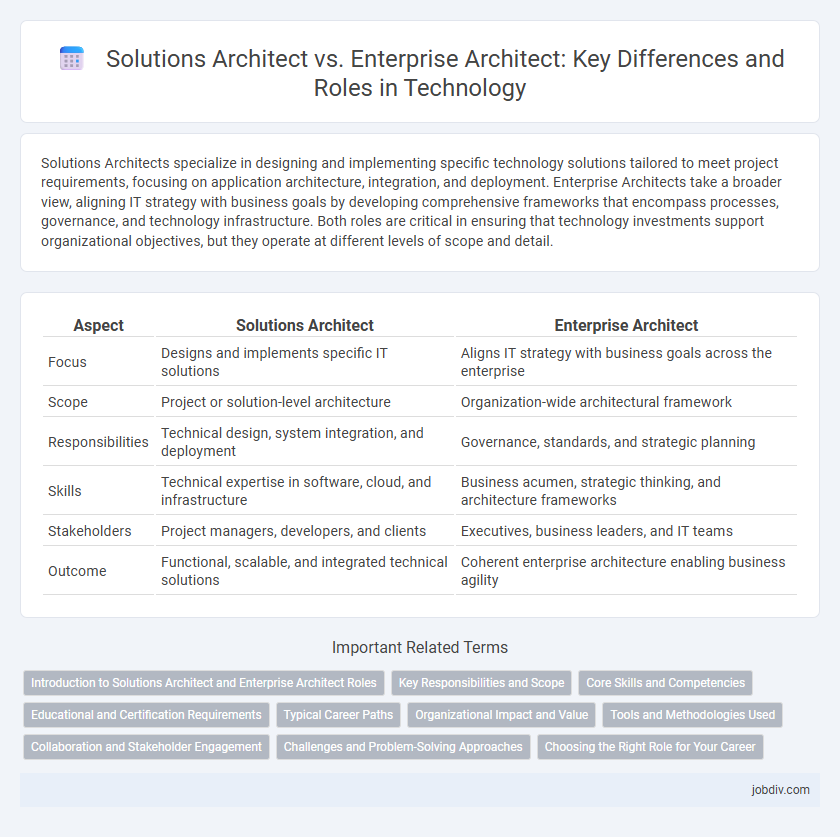Solutions Architects specialize in designing and implementing specific technology solutions tailored to meet project requirements, focusing on application architecture, integration, and deployment. Enterprise Architects take a broader view, aligning IT strategy with business goals by developing comprehensive frameworks that encompass processes, governance, and technology infrastructure. Both roles are critical in ensuring that technology investments support organizational objectives, but they operate at different levels of scope and detail.
Table of Comparison
| Aspect | Solutions Architect | Enterprise Architect |
|---|---|---|
| Focus | Designs and implements specific IT solutions | Aligns IT strategy with business goals across the enterprise |
| Scope | Project or solution-level architecture | Organization-wide architectural framework |
| Responsibilities | Technical design, system integration, and deployment | Governance, standards, and strategic planning |
| Skills | Technical expertise in software, cloud, and infrastructure | Business acumen, strategic thinking, and architecture frameworks |
| Stakeholders | Project managers, developers, and clients | Executives, business leaders, and IT teams |
| Outcome | Functional, scalable, and integrated technical solutions | Coherent enterprise architecture enabling business agility |
Introduction to Solutions Architect and Enterprise Architect Roles
Solutions Architects design and implement specific software solutions tailored to meet business needs, focusing on technical architecture and integration within projects. Enterprise Architects develop comprehensive IT strategies aligned with organizational goals, ensuring technology ecosystems support long-term business objectives. Both roles collaborate to bridge technical execution and strategic planning in enterprise technology environments.
Key Responsibilities and Scope
Solutions Architects design and implement specific technology solutions tailored to project requirements, focusing on technical architecture, integration, and implementation within a defined scope. Enterprise Architects operate at a strategic level, aligning IT infrastructure and business goals across the entire organization, managing enterprise-wide architecture frameworks and governance. The Solutions Architect's scope is project-specific, while the Enterprise Architect oversees holistic enterprise strategies and cross-functional alignment.
Core Skills and Competencies
Solutions Architects excel in designing and implementing technical solutions, emphasizing software architecture, system integration, and cloud technologies, while Enterprise Architects focus on aligning IT strategy with business goals, mastering enterprise frameworks like TOGAF and business process modeling. Both roles require strong analytical skills, stakeholder communication, and a deep understanding of IT infrastructures, but Solutions Architects prioritize hands-on technical expertise, whereas Enterprise Architects emphasize strategic planning and governance. Proficiency in frameworks, architectural principles, and technology stacks distinguishes each role's competencies in driving organizational IT success.
Educational and Certification Requirements
Solutions Architects typically require certifications such as AWS Certified Solutions Architect or Microsoft Certified: Azure Solutions Architect Expert, emphasizing expertise in cloud platforms, application design, and infrastructure. Enterprise Architects often pursue TOGAF (The Open Group Architecture Framework) certification or Certified Enterprise Architect credentials, highlighting strategic planning, business alignment, and governance skills. Both roles benefit from a bachelor's degree in computer science, information technology, or related fields, although Enterprise Architects may require advanced degrees in business or systems architecture to address broader organizational objectives.
Typical Career Paths
Solutions Architects often begin their careers as software developers or system engineers, progressing through roles that deepen their expertise in specific technologies and project delivery. Enterprise Architects typically have broader experience, advancing from roles in IT management, business analysis, or systems integration, emphasizing strategic planning and aligning IT with business goals. Both paths require continuous learning in emerging technologies and frameworks, but Enterprise Architects usually focus more on organizational governance and long-term IT strategy.
Organizational Impact and Value
Solutions Architects drive organizational impact by designing specific technology solutions that align with business needs, ensuring efficient project delivery and immediate operational improvements. Enterprise Architects create long-term value by developing comprehensive IT strategies that integrate technology, processes, and business goals across the entire organization, promoting scalability and innovation. The collaboration between Solutions Architects and Enterprise Architects optimizes technology investments and enhances overall business agility.
Tools and Methodologies Used
Solutions Architects primarily utilize cloud platforms like AWS, Azure, and Google Cloud, leveraging Infrastructure as Code (IaC) tools such as Terraform and CloudFormation to design scalable applications. Enterprise Architects focus on comprehensive frameworks including TOGAF, Zachman, and ArchiMate for aligning IT strategy with business goals, often using modeling tools like Sparx Systems Enterprise Architect and Bizzdesign. Both roles incorporate Agile and DevOps methodologies to enhance collaboration and continuous delivery within complex technology environments.
Collaboration and Stakeholder Engagement
Solutions Architects bridge the gap between business needs and technical solutions by collaborating closely with development teams and stakeholders to ensure design alignment and project success. Enterprise Architects engage with a broader range of stakeholders, including executives and business units, to align IT strategy with organizational goals and drive digital transformation. Effective collaboration for both roles requires strong communication skills, stakeholder management, and an understanding of business processes and technology landscapes.
Challenges and Problem-Solving Approaches
Solutions Architects tackle complex IT challenges by designing and implementing specific software solutions tailored to business needs, emphasizing scalability, integration, and technical feasibility. Enterprise Architects address broader organizational issues by aligning IT strategy with business goals, ensuring coherence across multiple projects and technologies while managing risk and governance. Both roles use problem-solving frameworks, but Solutions Architects focus on tactical execution, whereas Enterprise Architects emphasize strategic planning and holistic enterprise transformation.
Choosing the Right Role for Your Career
Choosing between a Solutions Architect and an Enterprise Architect depends on your career goals and expertise in technology strategy and implementation. Solutions Architects specialize in designing specific IT solutions tailored to business needs, focusing on application architecture, integration, and problem-solving at the project level. Enterprise Architects oversee the entire IT landscape, aligning technology initiatives with business objectives and shaping long-term digital transformation and infrastructure strategy.
Solutions Architect vs Enterprise Architect Infographic

 jobdiv.com
jobdiv.com